The physiological costs of reproduction in small mammals
- PMID: 17686735
- PMCID: PMC2606756
- DOI: 10.1098/rstb.2007.2145
The physiological costs of reproduction in small mammals
Abstract
Life-history trade-offs between components of fitness arise because reproduction entails both gains and costs. Costs of reproduction can be divided into ecological and physiological costs. The latter have been rarely studied yet are probably a dominant component of the effect. A deeper understanding of life-history evolution will only come about once these physiological costs are better understood. Physiological costs may be direct or indirect. Direct costs include the energy and nutrient demands of the reproductive event, and the morphological changes that are necessary to facilitate achieving these demands. Indirect costs may be optional 'compensatory costs' whereby the animal chooses to reduce investment in some other aspect of its physiology to maximize the input of resource to reproduction. Such costs may be distinguished from consequential costs that are an inescapable consequence of the reproductive event. In small mammals, the direct costs of reproduction involve increased energy, protein and calcium demands during pregnancy, but most particularly during lactation. Organ remodelling is necessary to achieve the high demands of lactation and involves growth of the alimentary tract and associated organs such as the liver and pancreas. Compensatory indirect costs include reductions in thermogenesis, immune function and physical activity. Obligatory consequential costs include hyperthermia, bone loss, disruption of sleep patterns and oxidative stress. This is unlikely to be a complete list. Our knowledge of these physiological costs is currently at best described as rudimentary. For some, we do not even know whether they are compensatory or obligatory. For almost all of them, we have no idea of exact mechanisms or how these costs translate into fitness trade-offs.
Figures
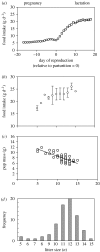
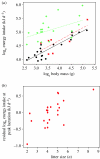
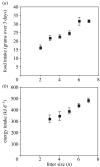
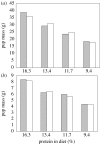
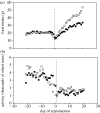

Similar articles
-
From physiology to fitness: the costs of a defensive adaptation in rattlesnakes.Physiol Biochem Zool. 2006 Jan-Feb;79(1):133-9. doi: 10.1086/498191. Epub 2005 Nov 14. Physiol Biochem Zool. 2006. PMID: 16380934
-
From gestation to weaning: Combining robust design and multi-event models unveils cost of lactation in a large herbivore.J Anim Ecol. 2017 Oct;86(6):1497-1509. doi: 10.1111/1365-2656.12736. Epub 2017 Oct 10. J Anim Ecol. 2017. PMID: 28772345
-
Effects of reproduction on immuno-suppression and oxidative damage, and hence support or otherwise for their roles as mechanisms underpinning life history trade-offs, are tissue and assay dependent.J Exp Biol. 2013 Nov 15;216(Pt 22):4242-50. doi: 10.1242/jeb.092049. Epub 2013 Aug 30. J Exp Biol. 2013. PMID: 23997195
-
Costs of reproduction in flowering plants.New Phytol. 2025 Jul;247(1):55-70. doi: 10.1111/nph.70166. Epub 2025 May 7. New Phytol. 2025. PMID: 40342244 Free PMC article. Review.
-
The role of energy availability in Mammalian hibernation: a cost-benefit approach.Physiol Biochem Zool. 2003 Mar-Apr;76(2):165-79. doi: 10.1086/367950. Physiol Biochem Zool. 2003. PMID: 12794670 Review.
Cited by
-
Presence of Mercury in an Arid Zone of Mexico: A Perspective Based on Biomonitoring of Mammals from Three Trophic Guilds.Biology (Basel). 2024 Oct 11;13(10):811. doi: 10.3390/biology13100811. Biology (Basel). 2024. PMID: 39452120 Free PMC article.
-
Reproductive resilience to food shortage in a small heterothermic primate.PLoS One. 2012;7(7):e41477. doi: 10.1371/journal.pone.0041477. Epub 2012 Jul 25. PLoS One. 2012. PMID: 22848507 Free PMC article.
-
Thermoregulation in endotherms: physiological principles and ecological consequences.J Comp Physiol B. 2015 Oct;185(7):709-27. doi: 10.1007/s00360-015-0909-5. Epub 2015 May 30. J Comp Physiol B. 2015. PMID: 26025431 Review.
-
The World Goes Bats: Living Longer and Tolerating Viruses.Cell Metab. 2020 Jul 7;32(1):31-43. doi: 10.1016/j.cmet.2020.06.013. Cell Metab. 2020. PMID: 32640245 Free PMC article. Review.
-
Constraint and cost of oxidative stress on reproduction: correlative evidence in laboratory mice and review of the literature.Front Zool. 2012 Dec 26;9(1):37. doi: 10.1186/1742-9994-9-37. Front Zool. 2012. PMID: 23268929 Free PMC article.
References
-
- Abdalla E.B, Kotby E.A, Johnson H.D. Physiological responses to heat-induced hyperthermia of pregnant and lactating ewes. Small Ruminant Res. 1993;11:125–134. doi:10.1016/0921-4488(93)90145-8 - DOI
-
- Adams R.A, Pedersen S.C, Thibault K.M, Jadin J, Petru B. Calcium as a limiting resource to insectivorous bats: can water holes provide a supplemental mineral source? J. Zool. 2003;260:189–194. doi:10.1017/S0952836903003613 - DOI
-
- Akesson A, Vahter M, Berglund M, Eklof T, Bremme K, Bjellerup P. Bone turnover from early pregnancy to postweaning. Acta Obstet. Gyn. Scan. 2004;83:1049–1055. doi:10.1111/j.0001-6349.2004.00428.x - DOI - PubMed
-
- Atramentowicz M. Optimal litter size—does it cost more to raise a large litter in Caluromys philander? Can. J. Zool. 1992;70:1511–1515.
Publication types
MeSH terms
LinkOut - more resources
Full Text Sources

